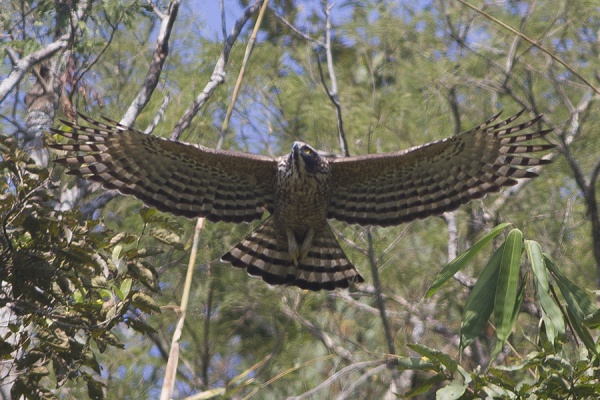Facts About Mountain hawk-eagle
The mountain hawk-eagle, also known as Hodgson's hawk-eagle, is a striking bird of prey found across Asia. Named after the naturalist Brian Houghton Hodgson, this eagle breeds in regions from northern India and Nepal to Thailand, Taiwan, and Japan. It thrives in forested areas and is an opportunistic predator, hunting birds, mammals, reptiles, and other vertebrates.
Description:
- Size: This raptor is quite large, measuring between 69 to 84 cm in length, with a wingspan ranging from 134 to 175 cm.
- Physical Features: It has a short but strong bill, a distinctive long crest, short wings, a three-banded tail, feathered legs, and powerful feet.
- Sexual Dimorphism: Females are generally larger than males.
- Subspecies: There are two recognized subspecies. The Japanese race tends to be paler with fewer markings compared to the nominate subspecies.
Distribution and Habitat:
- Range: The mountain hawk-eagle is found in the Himalayas, northeastern Pakistan, northern India, Nepal, Bhutan, northern Assam, Thailand, Laos, and possibly Vietnam.
- Preferred Habitat: They favor dense hill and montane forests, often residing in primary evergreen or mixed forests up to the tree line.
Behavior and Ecology:
- Adaptations: Designed for life in wooded habitats, these eagles are adept at maneuvering through forests.
- Diet: They are opportunistic hunters, feeding on a variety of prey, including small mammals, birds, and reptiles. They have been known to take down relatively large animals, including young ungulates, primates, and large birds.
- Predatory Relationships: They sometimes engage in interspecies predation with other eagles and owls.
Breeding:
- Season: In the Himalayas, their breeding season is from February to June, while in Japan, it’s from April to July.
- Nesting: Pairs build large stick nests high in forest trees, usually 12 to 30 meters above the ground.
- Reproduction: Typically, they lay 1 or 2 eggs. The female primarily incubates the eggs and takes charge of brooding and protecting the young, while the male is responsible for providing food.
Status:
- Conservation: Although not globally threatened, the mountain hawk-eagle is uncommon to rare in certain areas.
- Threats: They face challenges such as habitat degradation, deforestation, persecution, lead poisoning, and potential diseases. The Japanese population, in particular, is declining, raising concerns about genetic diversity and inbreeding.
